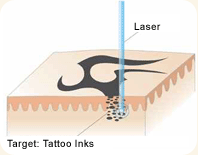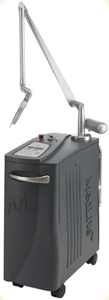|
Tattoo Removal
 Overview
For many, a tattoo can be a permanent reminder of a temporary emotion. Today's tattoos come in all shapes, colors and sizes. For the past 30 years, tattoo removal was accomplished using surgery techniques, which left individuals with unpleasant scarring. Now, with recent advances in medical technology, laser treatment has become the gold standard for removal of tattoos. High energy, pulsed laser technology removes the tattoo with reduced risk of scarring.
Laser tatto removal works by directing energy toward ink in the skin with concentrated colored light beams. These laser beams break up ink particles into tiny fragments, which are later cleared up by the immune system's scavenging cells. The process of fragmenting the ink particles requires a number of sessions, depending on the depth of the ink. The procedure is bloodless and no incisions are made. Individuals with fair skin and superficially placed tattoos on the arms, chest, buttocks or legs are the best candidates. Tattoos on darker-complected individuals, on the ankles or fingers, or on areas with less body fat are the most difficult to treat, with results being more variable. What to Expect
Laser tattoo removal usually takes a few minutes, but the time frame varies depending on the tattoo. Multiple sessions are required to remove most tattoos, split over 4–8 week periods. Most simple tattoos are removed in 2–4 treatments, while professional tattoos usually require 6–10 treatments.
 First, the skin's reaction to the laser is tested to determine the most effective energy. A small probe is then placed against the tattoo. Depending on the size of the tattoo, 10–30 pulses of the laser may be required in one session. After each laser treatment, ice is immediately placed on the tattoo to minimize swelling. After about 30 minutes, a topical antibiotic ointment is placed on the tattoo followed by a sterile dressing. The skin site should be cared for like sunburned skin. Side effects of laser procedures are generally few, but may include pigmentation changes of the skin and a small chance of scarring. To minimize discomfort, it is recommended to take Tylenol several hours before the procedure. Pain medications that thin blood and promote bruising are not recommended. To further decrease any pain, a local anesthetic ointment may be applied on the tattoo a few hours before the procedure, and in some cases, a local anesthetic may be injected into the tattoo beforehand.  Effectiveness and Results
Complete laser tattoo removal is based on several factors. These include the size, location, application, age, and color of the tattoo, as well as your health and ability to heal. Newer tattoos are generally more difficult to remove. Each patient's results will vary and realistic expectations are recommended. After each session, the body begins to repair any damaged skin, and the immune system further breaks down and carries away tattoo ink from the treated area. This leads to a lighter and less visible tattoo over time, progressively minimizing or removing the tattoo.
Our Technology
The MedLite C3 Q-Switched Nd:YAG Laser features short nanosecond pulse duration and high peak power for a very low risk of permanent tissue damage. Its longer 1064 nm wavelength significantly lowers the risk of hypopigmentation of the skin, as compared to other lasers. Furthermore, the short pulse duration limits the tissue's exposure to heat build-up, reducing the risk of scarring.
The MedLite C3's wavelength is ideal for removing red-colored ink, which is typically resistant to removal with other lasers. In all, this machine covers black, dark blue, and red ink tattoo removal, as well as epidermal and dermal pigmented lesion removal. | |||